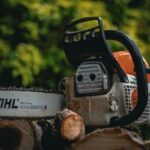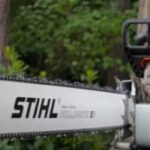As an Amazon Associate, this site earns commissions from qualifying purchases. For more information click here.
Gas leaf blowers are indispensable tools for maintaining large yards, offering efficiency and power to tackle debris and leaves with ease. However, using them effectively requires more than just pointing and blowing. In this guide, we’ll delve into the intricacies of using a gas leaf blower on large yards, covering everything from preparation to operation and maintenance.
Key Takeaways:
- Prepare thoroughly: Inspect equipment, clear debris, and assess wind direction before starting.
- Use efficient techniques: Work systematically, adjust power settings, and choose the right nozzle.
- Maintain regularly: Clean debris, service annually, and replace parts as needed for optimal performance.
Preparation
Before firing up your gas leaf blower, it’s crucial to prepare both the equipment and the workspace for optimal performance. Inspect the blower for any signs of damage, such as cracks or leaks. Pay particular attention to the integrity of the housing, fuel tank, and exhaust system.
Ensure that the air filter, spark plug, and fuel lines are clean and in good condition. Replace any worn or damaged components to prevent engine malfunctions. Tighten any loose screws or fittings to prevent vibrations during operation, which can lead to discomfort and premature wear of the blower.
Top up the fuel tank with a mixture of gasoline and two-stroke oil, following the manufacturer’s recommendations for the correct fuel-to-oil ratio. Avoid overfilling to prevent fuel spillage and potential fire hazards.
Assess the Yard
Remove any large debris, such as branches or rocks, that could damage the blower or cause injury during operation. Use a rake or garden gloves to clear the area effectively.
Identify the direction of prevailing winds to work with, rather than against, natural airflow. This will help maximize the efficiency of the blower and prevent debris from blowing back into cleared areas. Clear obstacles like toys, garden hoses, or furniture that could obstruct your path while blowing. Creating a clear workspace minimizes the risk of accidents and allows for uninterrupted operation.
Once the preparation is complete, it’s time to unleash the power of your gas leaf blower.
How to Use a Leaf Blower on Large Yards
- Place the blower on a flat, stable surface to ensure stability during startup and operation. Avoid uneven terrain or slippery surfaces that could compromise your balance.
- Prime the engine according to the manufacturer’s instructions to ensure easy starting, especially if the blower has been inactive for an extended period. This typically involves pressing a primer bulb to inject fuel into the carburetor.
- Hold the blower firmly with both hands and pull the starter cord with a smooth, controlled motion. Avoid jerking or yanking the cord, as this can cause strain or damage to the starter mechanism.
- Let the engine warm up for a few minutes before engaging full throttle. This allows the internal components to reach operating temperature and ensures optimal performance throughout the leaf-blowing session.
Choose the Right Nozzle
Gas leaf blowers typically come with different nozzles or attachments for various tasks, such as blowing, vacuuming, or mulching. Select the appropriate nozzle based on the size and layout of your yard, as well as the type of debris you need to clear.
Use a wide nozzle for clearing large open areas, such as lawns or driveways, where maximum coverage is desired. The wide airflow pattern disperses debris efficiently and minimizes the need for multiple passes.
Switch to a narrow nozzle for concentrating airflow in tight spaces or corners, such as around flower beds, shrubs, or fencing. The narrow profile allows for precise control and targeted blowing without disturbing delicate plants or landscaping features.
Experiment with different attachments to find the most effective option for your yard, taking into account factors like airflow velocity, noise level, and fuel consumption. Some blowers also offer adjustable nozzle settings for added versatility in various operating conditions.

Using Leaf Blowers Efficiently
- Work in a systematic pattern, starting from the farthest corner and moving toward the center of the yard. This ensures thorough coverage and prevents overlooked areas or uneven blowing patterns.
- Keep the nozzle at a consistent distance above the ground to achieve uniform results across the entire yard. Aim for a height of approximately 6-12 inches, depending on the density of the debris and the power of the blower.
- Use sweeping motions rather than stationary blasts to disperse debris evenly and prevent accumulation in concentrated piles. Start from the outer edges of the work area and gradually work your way inward for maximum efficiency.
- Angle the airflow slightly downward to prevent debris from blowing back toward you or onto adjacent surfaces. This minimizes the risk of injury or property damage and ensures a clean, debris-free finish.
Power Settings Guide
Gas leaf blowers often feature variable speed settings to accommodate different tasks and operating conditions. Familiarize yourself with the available speed settings and adjust them as needed to suit the current task.
Start at a lower speed when clearing lightweight debris, such as dry leaves or grass clippings, to avoid excessive noise and disturbance. This also conserves fuel and extends the runtime of the blower for longer work sessions.
Increase the throttle to a higher speed for stubborn or heavy accumulations, such as wet leaves or packed dirt. Gradually ramp up the power as needed, but avoid running the blower at maximum speed for extended periods to prevent overheating or premature wear.
Pay attention to the engine sound and exhaust emissions while operating the blower, as these can indicate the optimal power setting for the current conditions. Adjust the throttle accordingly to maintain a balance between performance, efficiency, and environmental impact. if it won’t start, this could be due to a seized engine.
Maintenance
Proper maintenance is essential to prolonging the lifespan and efficiency of your gas leaf blower. After each use, remove debris and dirt buildup from the air intake, fan blades, and exhaust ports using a soft brush or compressed air. Pay close attention to areas where debris tends to accumulate, such as around the engine housing and fuel tank.
Inspect the air filter and clean or replace it as needed to maintain optimal airflow and engine performance. A clogged or dirty air filter can restrict airflow and cause the engine to run lean, leading to reduced power output and potential damage.
Wipe down the exterior of the blower with a damp cloth to remove dirt, grease, or other contaminants. Avoid using harsh chemicals or abrasive cleaners, as these can damage the finish or corrode metal surfaces over time.
When to Service Leaf Blowers:
Schedule annual maintenance tasks, such as spark plug replacement, carburetor adjustment, and fuel system inspection, to keep the engine running smoothly and efficiently. Consult the owner’s manual or seek professional assistance for complex or unfamiliar procedures.
Replace the spark plug at least once per season or as recommended by the manufacturer to ensure reliable ignition and consistent performance. Use a spark plug wrench to remove the old plug and install the new one, taking care not to overtighten or cross-thread the threads.
Check the carburetor and fuel system for signs of wear, corrosion, or leaks, and address any issues promptly to prevent fuel contamination or engine damage. Inspect fuel lines, gaskets, and seals for cracks or deterioration, and replace them as needed to maintain fuel integrity.
Clean or replace the fuel filter and fuel tank vent periodically to prevent clogs or restrictions that can impede fuel flow and cause starting or running problems. Use compressed air or a small brush to remove dirt, debris, or varnish buildup from the filter and vent openings.
How Long Does a Leaf Blower Take to Clean a Yard?
The time it takes for a gas leaf blower to clean a large yard can vary significantly based on several factors. Firstly, the size of the yard plays a crucial role. A larger yard will naturally require more time to clean compared to a smaller one.
Additionally, the layout and complexity of the yard, including the presence of obstacles like trees, shrubs, flower beds, and structures, can affect the cleaning time. Yards with intricate landscaping or numerous obstacles may take longer to navigate and clear effectively.
Moreover, the density and type of debris present in the yard influence the cleaning time. Light, dry leaves are typically easier and quicker to clear compared to heavy, wet leaves or other debris such as twigs, branches, and pine cones. Dense accumulations of debris may require multiple passes or adjustments to the blower’s power settings to achieve thorough cleaning.
Considerations
The power and efficiency of the gas leaf blower itself also play a significant role in determining cleaning time. Higher-powered blowers with larger engines and airflow capacities can cover larger areas more quickly and effectively. Gas blowers with variable speed settings allow operators to adjust the airflow according to the task at hand, which can help optimize cleaning efficiency and reduce overall time.
The operator’s skill and technique influence the cleaning time. Experienced users who employ efficient techniques, such as working in a systematic pattern, maintaining consistent nozzle height, and using sweeping motions, can complete the job more quickly than inexperienced users who may struggle with handling or positioning the blower effectively.
Safety Guidelines for Gas Leaf Blowers
Using a gas leaf blower can be highly effective for yard maintenance, but it’s essential to prioritize safety to prevent accidents or injuries. Here are some important safety tips to keep in mind when operating a gas leaf blower:
Wear Protective Gear
- Always wear safety goggles or a full-face shield to protect your eyes from flying debris, dust, and other particles stirred up by the blower’s powerful airflow.
- Use hearing protection, such as earplugs or earmuffs, to reduce the risk of hearing damage from prolonged exposure to the blower’s noise.
- Wear sturdy, closed-toe shoes with slip-resistant soles to provide traction and protect your feet from sharp objects or debris on the ground.
- Consider wearing long pants, a long-sleeved shirt, and work gloves to shield your skin from scratches, cuts, or irritation caused by debris or vegetation.
Mind Your Surroundings
Before starting the blower, survey the work area for obstacles, hazards, and other people or pets who may be nearby. Clear the area of obstacles like rocks, branches, toys, or garden hoses to prevent accidents.
Be aware of your surroundings at all times while operating the blower, especially when working near fences, buildings, vehicles, or other structures. Maintain a safe distance from these objects to avoid collisions or damage.
Avoid operating the blower in wet or slippery conditions, as this can increase the risk of slips, falls, or electrical hazards. Wait until the ground is dry and stable before using the blower.
Handle Fuel Safely
Handle gasoline and two-stroke oil with care, as they are flammable and potentially hazardous if mishandled. Store fuel in approved containers and keep them away from sources of heat, sparks, or open flames. Refuel the blower outdoors in a well-ventilated area to minimize the risk of exposure to fuel vapors and prevent accidental spills or leaks.
Allow the engine to cool down before refueling to reduce the risk of ignition. Clean up any fuel spills immediately and dispose of soiled rags or absorbent materials properly to prevent environmental contamination and fire hazards.
Operate with Care
Familiarize yourself with the blower’s controls, features, and operating instructions before use. Follow the manufacturer’s recommendations for starting, operating, and shutting down the blower to prevent accidents or damage.
Hold the blower with both hands at all times to maintain control and stability during operation. Keep one hand on the handle and the other on the throttle trigger to regulate airflow and power effectively. Avoid pointing the blower nozzle at people, animals, or fragile objects, as the high-speed airflow can cause injury or damage. Always direct the airflow away from yourself and others to prevent accidents.
Take frequent breaks to rest and hydrate, especially during extended periods of use. Fatigue can impair judgment and coordination, increasing the risk of accidents or injuries.
Conclusion
Mastering the gas leaf blower is a combination of proper preparation, effective operation, and regular maintenance. By following the guidelines outlined in this guide, you can harness the full potential of your equipment to keep your large yard pristine throughout the seasons. Remember to prioritize safety, efficiency, and environmental responsibility in every aspect of leaf blowing activity. With practice and attention to detail, you can achieve professional-quality results with minimal effort and maximum satisfaction.

I love the outdoors and all the tools for maintaining gardens, yards and lawns. The only thing I am more passionate about is sharing what I know about garden and outdoor equipment.


